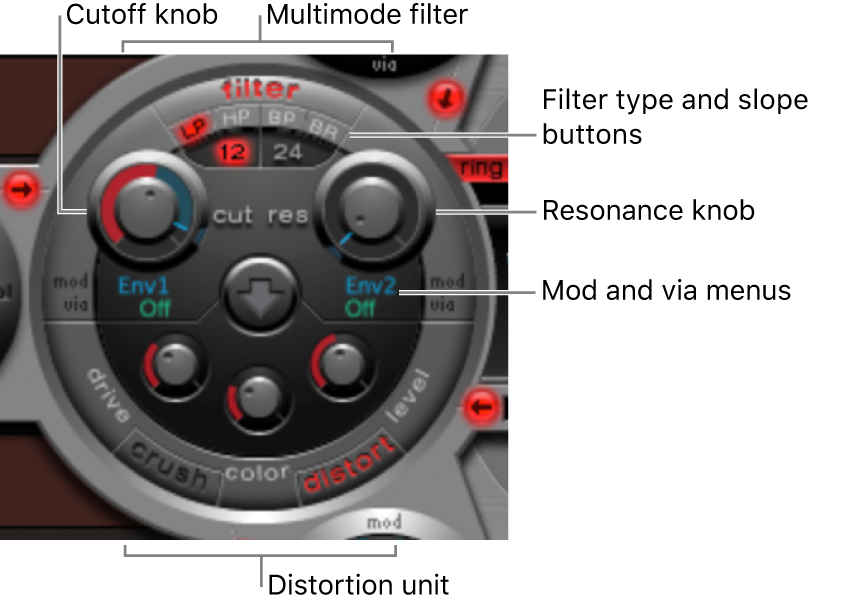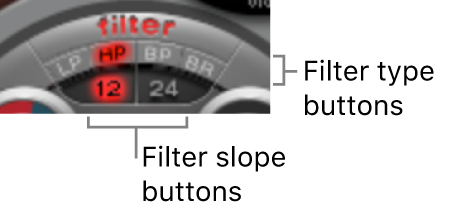MainStage User Guide
- Welcome
-
- Overview of Edit mode
-
- Select patches and sets in the Patch List
- Copy, paste, and delete patches
- Reorder and move patches in the Patch List
- Add and rename patches
- Create a patch from several patches
-
- Overview of the Patch Settings Inspector
- Select patch settings in the Patch Library
- Set the time signature for patches
- Change the tempo when you select a patch
- Set program change and bank numbers
- Defer patch changes
- Instantly silence the previous patch
- Change patch icons
- Transpose the pitch of incoming notes for a patch
- Change the tuning for a patch
- Add text notes to a patch
-
- Overview of channel strips
- Add a channel strip
- Change a channel strip setting
- Configure channel strip components
- Show signal flow channel strips
- Hide the metronome channel strip
- Create an alias of a channel strip
- Add a patch bus
- Set channel strip pan or balance positions
- Set channel strip volume levels
- Mute and solo channel strips
- Use multiple instrument outputs
- Use external MIDI instruments
- Reorganize channel strips
- Delete channel strips
-
- Overview of the Channel Strip Inspector
- Choose channel strip settings
- Rename channel strips
- Change channel strip colors
- Change channel strip icons
- Use feedback protection with channel strips
- Set keyboard input for a software instrument channel strip
- Transpose individual software instruments
- Filter MIDI messages
- Scale channel strip velocity
- Set channel strips to ignore Hermode tuning
- Override concert- and set-level key ranges
- Add text notes to a channel strip in the Channel Strip Inspector
- Route audio via send effects
-
- Screen Control Inspector overview
- Replace parameter labels
- Choose custom colors for screen controls
- Change background or grouped screen control appearance
- Set screen controls to show the hardware value
- Set parameter change behavior for screen controls
- Set hardware matching behavior for screen controls
- Reset and compare changes to a patch
- Override concert- and set-level mappings
-
- Overview of mapping screen controls
- Map to channel strip and plug-in parameters
- Map screen controls to actions
- Map a screen control to multiple parameters
- Use screen controls to display PDF document pages
- Edit the saved value for a mapped parameter
- Set drum pads or buttons to use note velocity
- Map screen controls to all channel strips in a patch
- Undo screen control parameter mappings
- Remove screen control mappings
- Work with graphs
- Create controller transforms
- Share patches and sets between concerts
- Record the audio output of a concert
-
- Overview of concerts
- Create a concert
- Open and close concerts
- Save concerts
- How saving affects parameter values
- Clean up concerts
- Consolidate assets in a concert
- Rename the current concert
-
- Overview of the Concert Settings Inspector
- Set MIDI Routing to channel strips
- Transpose incoming note pitch for a concert
- Define the program change message source
- Send unused program changes to channel strips
- Set the time signature for a concert
- Change the tuning for a concert
- Set the pan law for a concert
- Add text notes to a concert
- Control the metronome
- Silence MIDI notes
- Mute audio output
-
- Layout mode overview
-
- Screen control parameter editing overview
- Lift and stamp screen control parameters
- Reset screen control parameters
- Common screen control parameters
- Keyboard screen control parameters
- MIDI activity screen control parameters
- Drum pad screen control parameters
- Waveform screen control parameters
- Selector screen control parameters
- Text screen control parameters
- Background screen control parameters
- How MainStage passes through MIDI messages
- Export and import layouts
- Change the aspect ratio of a layout
-
- Before performing live
- Use Perform mode
- Screen controls in performance
- Tempo changes during performance
- Tips for performing with keyboard controllers
- Tips for performing with guitars and other instruments
- Tune guitars and other instruments with the Tuner
- The Playback plug-in in performance
- Record your performances
- After the performance
- Tips for complex hardware setups
-
- Overview of keyboard shortcuts and command sets
-
- Concerts and layouts keyboard shortcuts
- Patches and sets (Edit mode) keyboard shortcuts
- Editing keyboard shortcuts
- Actions keyboard shortcuts
- Parameter mapping (Edit mode) keyboard shortcuts
- Channel strips (Edit mode) keyboard shortcuts
- Screen controls (Layout mode) keyboard shortcuts
- Perform in Full Screen keyboard shortcuts
- Window and view keyboard shortcuts
- Help and support keyboard shortcuts
-
-
- Use MIDI plug-ins
-
- Arpeggiator overview
- Arpeggiator control parameters
- Note order parameters overview
- Note order variations
- Note order inversions
- Arpeggiator pattern parameters overview
- Use Live mode
- Use Grid mode
- Arpeggiator options parameters
- Arpeggiator keyboard parameters
- Use keyboard parameters
- Assign controllers
- Modifier controls
- Note Repeater controls
- Randomizer controls
-
- Use the Scripter
- Use the Script Editor
- Scripter API overview
- MIDI processing functions overview
- HandleMIDI function
- ProcessMIDI function
- GetParameter function
- SetParameter function
- ParameterChanged function
- Reset function
- JavaScript objects overview
- Use the JavaScript Event object
- Use the JavaScript TimingInfo object
- Use the Trace object
- Use the MIDI event beatPos property
- Use the JavaScript MIDI object
- Create Scripter controls
- Transposer MIDI plug-in controls
-
-
- Alchemy overview
- Alchemy interface overview
- Alchemy Name bar
- Alchemy file locations
-
- Alchemy source overview
- Source master controls
- Import browser
- Source subpage controls
- Source filter controls
- Source filter use tips
- Source elements overview
- Additive element controls
- Additive element effects
- Spectral element controls
- Spectral element effects
- Pitch correction controls
- Formant filter controls
- Granular element controls
- Sampler element controls
- VA element controls
- Source modulations
- Morph controls
- Alchemy master voice section
- Alchemy Extended parameters
-
- Playback plug-in overview
- Add a Playback plug-in
- Playback interface
- Use the Playback waveform display
- Playback transport and function buttons
- Playback information display
- Playback Sync, Snap To, and Play From parameters
- Use the Playback group functions
- Use the Playback Action menu and File field
- Use markers with the Playback plug-in
-
- Sculpture overview
- Sculpture interface
- Global parameters
- Amplitude envelope parameters
- Use the Waveshaper
- Filter parameters
- Output parameters
- Define MIDI controllers
- Extended parameters
-

Ultrabeat filter section in MainStage
The Ultrabeat multimode filter can dramatically, or subtly, alter the timbre of your drum sounds.

Filter parameters
Filter (On/Off) button: Turn the entire Filter section on or off. Deactivating the Filter section makes it easier to hear adjustments to other sound parameters, as the filter always heavily affects the sound. If the Filter label is red, the filter is engaged. If gray, the filter is disabled.
Filter Type buttons: Switch the filter between lowpass, highpass, bandpass, or band-rejection filter types.
Filter Slope buttons: Switch the filter between different slopes.
Cutoff and Resonance knobs: Rotate to set the cutoff/center frequency and resonance/bandwidth of the filter.
Mod and via pop-up menus: Choose the modulation source (and via source) for the Cutoff and Resonance parameters. See Mod and via modulation.
Set the Ultrabeat filter type
The filter can operate in several modes, allowing specific frequency bands to be filtered (cut away) or emphasized.
In MainStage, to select a filter type, click one of the following buttons:
LP (lowpass): This filter type allows frequencies that fall below the cutoff frequency to pass. When set to LP, the filter operates as a lowpass filter. The slope of the filter can be set to 12 or 24 dB/octave in LP mode.
HP (highpass): This filter type allows frequencies above the cutoff frequency to pass. When set to HP, the filter operates as a highpass filter. The slope of the filter can be set to 12 or 24 dB/octave in HP mode.
BP (bandpass): The frequency band directly surrounding the center frequency (set with the Cutoff knob) is allowed to pass. All other frequencies are cut. The Resonance parameter controls the width of the frequency band. The bandpass filter is a two-pole filter with a slope of 6 or 12 dB/octave on each side of the center frequency of the band.
BR (band rejection): The frequency band directly surrounding the center frequency (set with the Cutoff knob) is rejected, while the frequencies outside this band can pass. The Resonance parameter controls the width of the rejected frequency band.

Set the Ultrabeat filter slope
Most filters don’t completely suppress the portion of the signal that falls outside the frequency range defined by the Cutoff parameter. Frequencies that are located close to the cutoff frequency are generally reduced less than those that are farther away. The higher the slope value, the more apparent the level difference is between frequencies that are near to the Cutoff frequency and those that are farther away from it.
In MainStage, click the 12 dB or 24 dB button. The slope (curve) chosen for the Filter expresses the amount of rejection in decibels per octave. The steeper the slope, the more severely the level of signals below the cutoff frequency is affected in each octave.

Use the Ultrabeat filter Cutoff parameter
In MainStage, rotate the Cutoff Frequency (Cut) parameter to control the brilliance or determine the center frequency of the signal.
In a lowpass filter, the higher the cutoff frequency is set, the higher the frequencies of signals that are allowed to pass.
In a highpass filter, the cutoff frequency determines the point where lower frequencies are suppressed, with only upper frequencies allowed to pass.
In a bandpass/band-rejection filter, the cutoff frequency determines the center frequency for the bandpass or band-rejection filter.
Use the Ultrabeat filter Resonance parameter
In MainStage, rotate the Resonance (Res) parameter to emphasize or suppress portions of the signal above or below the defined cutoff frequency, or to determine the width of the band that surrounds the cutoff frequency.
In a lowpass filter, Resonance emphasizes or suppresses signals below the cutoff frequency.
In a highpass filter, Resonance emphasizes or suppresses signals above the cutoff frequency.
In bandpass/band-rejection filters, resonance determines the width of the frequency band that surrounds the center frequency (set with the Cutoff Frequency parameter).
Set signal flow order through the Ultrabeat filter and distortion unit
The output signals of both oscillators, the ring modulator, and the noise generator are sent to the central Filter section (if not bypassed with the various Signal Flow buttons). The Filter section offers a multimode filter and a distortion unit. Sounds are passed through the filter and distortion unit as determined by the direction of the arrow found in the center of the filter section.
In MainStage, click the arrow to change the signal flow order between the following:
First the Distortion unit, then the Filter circuit (arrow pointing up)
First the Filter circuit, then the Distortion unit (arrow pointing down).

Download the guides:
MainStage User Guide: Apple Books | PDF
MainStage Instruments: Apple Books | PDF
MainStage Effects: Apple Books | PDF